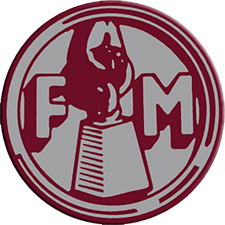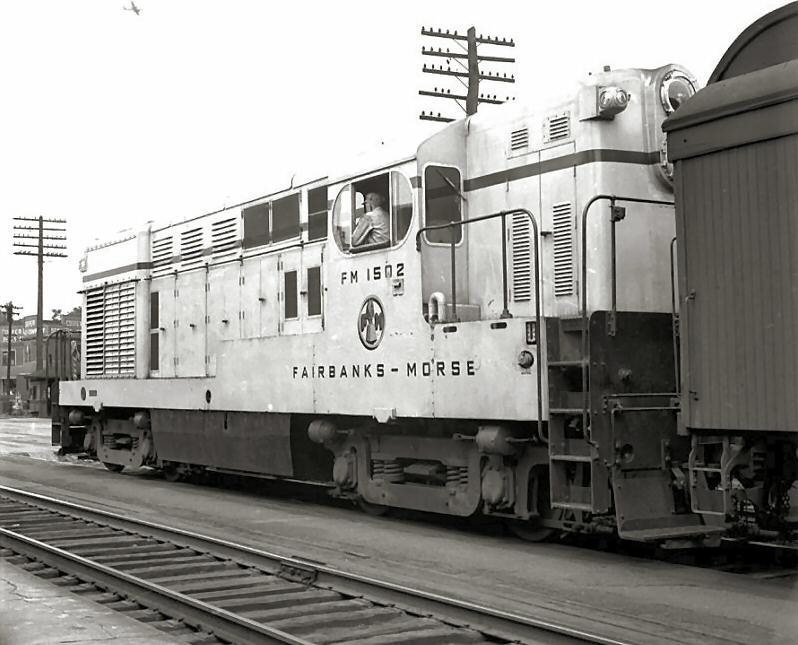Specific Item Information: Lenz decoder version
Model Information: Atlas introduced the Fairbanks-Morse H15-44 and H16-44 models in 2003. These two body styles share the same internal mechanism. The models are standard high-quality modern mechanisms featuring split-frames, dual flywheels, and magnetic operating knuckle couplers.
They have typical high-end smooth and quiet running and can pull the expected 30+ cars on a flat surface.
DCC Information: These models are DCC-Friendly and accept drop-in decoders such as the Digitrax DN163A0.
The DCC install requires some work, because of the reversible green/red classification lights, that will not come with the above replacement drop-in decoder. For this reason, these models are decidedly DCC-Friendly rather than DCC-Ready. In our opinion, it is worth the extra $ to buy a decoder-equipped version (with a NCE decoder) rather than do it yourself unless you are very comfortable with a soldering iron. Brad Myers has an excellent guide (NScaleStations Blog) on how to do it if you are feeling brave.
The DCC install requires some work, because of the reversible green/red classification lights, that will not come with the above replacement drop-in decoder. For this reason, these models are decidedly DCC-Friendly rather than DCC-Ready. In our opinion, it is worth the extra $ to buy a decoder-equipped version (with a NCE decoder) rather than do it yourself unless you are very comfortable with a soldering iron. Brad Myers has an excellent guide (NScaleStations Blog) on how to do it if you are feeling brave.
Prototype History: The FM H-15-44 was a road switcher manufactured by Fairbanks-Morse from September 1947 to June 1950. The locomotive was powered by a 1,500-horsepower (1,100 kW), eight-cylinder opposed piston engine as its prime mover, and was configured in a B-B wheel arrangement mounted atop a pair of two-axle AAR Type-B road trucks with all axles powered. The H-15-44 featured an offset cab design that provided space for an optional steam generator in the short hood, making the model versatile enough to work in passenger service as well as freight duty.
Raymond Loewy heavily influenced the look of the unit, which emphasized sloping lines and accented such features as the radiator shutters and headlight mounting, as is found on CNJR #1501 and KCS #40. The cab-side window assembly incorporated "half moon"-shaped inoperable panes which resulted in an overall oblong shape. The platform (underframe) was shared with F-M's 2,000-horsepower (1,500 kW) end cab road switcher, the FM H-20-44, as was the carbody to some extent. The platform and carbody was also utilized by the H-15-44's successor, the FM H-16-44.
Only 35 units were built for American railroads and none exist today.
From Wikipedia
Read more on American-Rails.com
Full F-M H-15-44 data sheet on The Diesel Shop.
Raymond Loewy heavily influenced the look of the unit, which emphasized sloping lines and accented such features as the radiator shutters and headlight mounting, as is found on CNJR #1501 and KCS #40. The cab-side window assembly incorporated "half moon"-shaped inoperable panes which resulted in an overall oblong shape. The platform (underframe) was shared with F-M's 2,000-horsepower (1,500 kW) end cab road switcher, the FM H-20-44, as was the carbody to some extent. The platform and carbody was also utilized by the H-15-44's successor, the FM H-16-44.
Only 35 units were built for American railroads and none exist today.
From Wikipedia
Read more on American-Rails.com
Full F-M H-15-44 data sheet on The Diesel Shop.
Road Name History: The Chicago, Rock Island and Pacific Railroad (CRI&P RR) (reporting marks RI, ROCK) was a Class I railroad in the United States. It was better known as the Rock Island Line, or, in its final years, The Rock. At the end of 1970 it operated 7183 miles of road on 10669 miles of track; that year it reported 20557 million ton-miles of revenue freight and 118 million passenger-miles. (Those totals may or may not include the former Burlington-Rock Island Railroad.)
Its predecessor, the Rock Island and La Salle Railroad Company, was incorporated in Illinois on February 27, 1847, and an amended charter was approved on February 7, 1851, as the Chicago and Rock Island Railroad. Construction began October 1, 1851, in Chicago, and the first train was operated on October 10, 1852, between Chicago and Joliet. Construction continued on through La Salle, and Rock Island was reached on February 22, 1854, becoming the first railroad to connect Chicago with the Mississippi River.
In 1980 Rock Island was liquidated. The railroad's locomotives, rail cars, equipment, tracks, and real estate were sold to other railroads or to scrappers. William Gibbons (the trustee) was able to raise more than $500 million in the liquidation, paying off all the railroad's creditors, bondholders and all other debts in full at face value with interest. Henry Crown was ultimately proven correct, as both he and other bondholders who had purchased Rock Island debt for cents on the dollar during the low ebb in prices did especially well.
Read more on Wikipedia and Rock Island Technical Society.
Its predecessor, the Rock Island and La Salle Railroad Company, was incorporated in Illinois on February 27, 1847, and an amended charter was approved on February 7, 1851, as the Chicago and Rock Island Railroad. Construction began October 1, 1851, in Chicago, and the first train was operated on October 10, 1852, between Chicago and Joliet. Construction continued on through La Salle, and Rock Island was reached on February 22, 1854, becoming the first railroad to connect Chicago with the Mississippi River.
In 1980 Rock Island was liquidated. The railroad's locomotives, rail cars, equipment, tracks, and real estate were sold to other railroads or to scrappers. William Gibbons (the trustee) was able to raise more than $500 million in the liquidation, paying off all the railroad's creditors, bondholders and all other debts in full at face value with interest. Henry Crown was ultimately proven correct, as both he and other bondholders who had purchased Rock Island debt for cents on the dollar during the low ebb in prices did especially well.
Read more on Wikipedia and Rock Island Technical Society.
Brand/Importer Information: In 1924 Stephan Schaffan, Sr. founded the Atlas Tool Company in Newark, New Jersey. In 1933 his son, Stephan Schaffan, Jr., came to work for his father at the age of sixteen. Steve Jr. built model airplanes as a hobby and frequented a local hobby shop. Being an enterprising young man, he would often ask the owner if there was anything he could do to earn some extra spending money. Tired of listening to his requests, the hobby-store owner threw some model railroad track parts his way and said, "Here, see if you can improve on this".
In those days, railroad modelers had to assemble and build everything from scratch. Steve Jr. created a "switch kit" which sold so well, that the entire family worked on them in the basement at night, while doing business as usual in the machine shop during the day.
Subsequently, Steve Jr. engineered the stapling of rail to fiber track, along with inventing the first practical rail joiner and pre-assembled turnouts and flexible track. All of these products, and more, helped to popularize model railroading and assisted in the creation of a mass-market hobby. The budding entrepreneur quickly outgrew the limitations of a basement and small garage operation. Realizing they could actually make a living selling track and related products, Steve and his father had the first factory built in Hillside, New Jersey at 413 Florence Avenue in 1947. On September 30, 1949, the Atlas Tool Company was officially incorporated as a New Jersey company.
In 1985, Steve was honored posthumously for his inventions by the Model Railroad Industry Association and was inducted into the Model Railroad Industry Hall of Fame in Baltimore, Maryland. In addition, Steve was nominated and entered into the National Model Railroad Association Pioneers of Model Railroading in 1995.
In the early 1990s, the Atlas Tool Company changed its name to Atlas Model Railroad Company, Inc.
In those days, railroad modelers had to assemble and build everything from scratch. Steve Jr. created a "switch kit" which sold so well, that the entire family worked on them in the basement at night, while doing business as usual in the machine shop during the day.
Subsequently, Steve Jr. engineered the stapling of rail to fiber track, along with inventing the first practical rail joiner and pre-assembled turnouts and flexible track. All of these products, and more, helped to popularize model railroading and assisted in the creation of a mass-market hobby. The budding entrepreneur quickly outgrew the limitations of a basement and small garage operation. Realizing they could actually make a living selling track and related products, Steve and his father had the first factory built in Hillside, New Jersey at 413 Florence Avenue in 1947. On September 30, 1949, the Atlas Tool Company was officially incorporated as a New Jersey company.
In 1985, Steve was honored posthumously for his inventions by the Model Railroad Industry Association and was inducted into the Model Railroad Industry Hall of Fame in Baltimore, Maryland. In addition, Steve was nominated and entered into the National Model Railroad Association Pioneers of Model Railroading in 1995.
In the early 1990s, the Atlas Tool Company changed its name to Atlas Model Railroad Company, Inc.
Item created by: Steve German on 2016-04-24 21:58:02. Last edited by Alain LM on 2018-08-19 05:24:38
If you see errors or missing data in this entry, please feel free to log in and edit it. Anyone with a Gmail account can log in instantly.
If you see errors or missing data in this entry, please feel free to log in and edit it. Anyone with a Gmail account can log in instantly.











